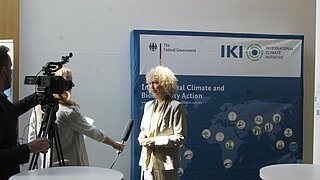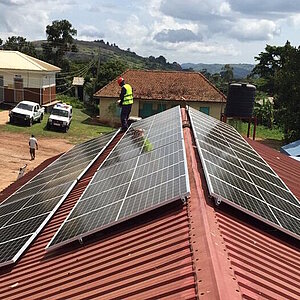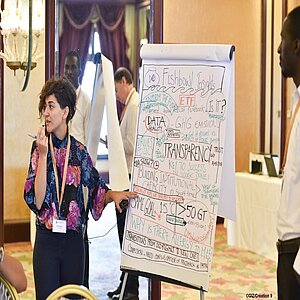Interview: Moving climate action to a higher level

Johanna Arriagada Díaz and Alfonso Galarce from the new Climate Change Division in the Ministry of Environment in Chile talk about how the creation of new structures and the introduction of a carbon tax accelerate climate actions.
At the sidelines of the Global NDC Conference in May 2017 in Berlin Johanna Arriagada Díaz and Alfonso Galarce from the Climate Change Division in the Ministry of the Environment in Chile talked about the development in Chile since the Paris Agreement. They explain how the creation of new structures supports the implementation of Chile’s nationally determined contributions (NDCs) and how the introduction of a carbon tax motivates the private sector to engage in mitigation actions.
Since the decisions were reached at COP21, what has been happening in Chile with regard to implementing the NDCs? What main steps have been taken?
ALFONSO GALARCE: On 12 April the President of Chile enacted the Paris Agreement, which had already been approved in February this year. In addition, the Government established the Sustainability and Climate Change Agency.
 JOHANNA ARRIAGADA DÍAZ: Another important step was the creation of the Climate Change Division within the Ministry of Environment. Transforming what was the Department of Climate Change into a new Climate Change Division moved the issue to a higher level. The Division has three departments: one on mitigation, one on adaptation, and one on climate financing and negotiations. We have also made progress on setting up Chile’s subnational climate change institutions. In three of the country’s 15 regions we now have regional climate change committees in place.
JOHANNA ARRIAGADA DÍAZ: Another important step was the creation of the Climate Change Division within the Ministry of Environment. Transforming what was the Department of Climate Change into a new Climate Change Division moved the issue to a higher level. The Division has three departments: one on mitigation, one on adaptation, and one on climate financing and negotiations. We have also made progress on setting up Chile’s subnational climate change institutions. In three of the country’s 15 regions we now have regional climate change committees in place.
Have the regions already defined their own targets and activities for implementing the NDCs?
ALFONSO GALARCE: The process of drawing up specific plans for regional action has just started. Regional committees are defining policies and planning how to implement different projects at the subnational level. This is where the Sustainability and Climate Change Agency comes into play. Drawing on the work of a predecessor agency, this new agency supports interaction between private firms, communities and the public sector, and is tasked with fostering technology transformation in small companies and private firms.
Does the agency work directly with companies or with private sector associations?
ALFONSO GALARCE: With both. The Agency works directly with companies and with associations. The Agency also knows how to operate in the regions. This knowledge is very valuable for us in the ministries because, although we draw up all the national policies, we do not have much experience of working directly with communities in the regions. Exchange with the Agency is very important for implementing the NDC.
How interested is the private sector in contributing to NDC implementation and taking on responsibilities?
 ALFONSO GALARCE: The Chilean Government recently implemented a tax reform that included the introduction of a carbon tax. This reform has increased private sector interest in this area because, now, companies are required to pay not only for their CO2 emissions, but also for their local pollutant emissions, which includes particulate matter, SO2 and NOx This innovation is beneficial as it links both global emissions and local emissions, which means the tax focuses on the main polluters. They will start declaring their emissions this year and, from next year onwards, will have to pay the tax. The carbon tax is changing their minds about the need to reduce their CO2 emissions.
ALFONSO GALARCE: The Chilean Government recently implemented a tax reform that included the introduction of a carbon tax. This reform has increased private sector interest in this area because, now, companies are required to pay not only for their CO2 emissions, but also for their local pollutant emissions, which includes particulate matter, SO2 and NOx This innovation is beneficial as it links both global emissions and local emissions, which means the tax focuses on the main polluters. They will start declaring their emissions this year and, from next year onwards, will have to pay the tax. The carbon tax is changing their minds about the need to reduce their CO2 emissions.
The carbon tax is also linked to energy policy. Throughout 2016 the government reworked its energy policies and developed the Energía 2050 agenda, which sets the rules for the energy sector and promotes the expansion of renewable energy. Chile is now aiming for a share of 20% of renewable energy in the energy mix by 2020 and 70% by 2050. Energy prices, in the last energy auction called by the government, in November 2016, fell sharply, with a 63% drop in prices, where solar plants offered the lowest prices. The introduction of a carbon tax contributed to give a strong signal to the market about carbon pricing.
So, has Chilean companies’ trust in the country’s NDC implementation plans increased?
ALFONSO GALARCE: Yes. This is a very important issue. We did not provide companies with any subsidies for renewable energy. Setting the long-term goal of increasing the share of renewables in the total energy supply proved sufficient to change the way companies were investing.
It seems like Chile is undergoing a real transformation.
ALFONSO GALARCE: Yes, but so far these changes are mainly happening in big companies, which only account for 10% of the total number of companies in Chile. The remaining 90% are small and medium-sized companies (SMEs). The agency will work closely with these SMEs because, at present, they do not see climate change as a problem. They have to deal with problems caused by climate change, but they do not see the connection. The challenge is to translate climate language into technical and entrepreneurial language. This will be a very important task for the agency.
What are your other priorities and what next steps will you take in the near future to advance NDC implementation in Chile?
ALFONSO GALARCE: Our biggest challenges are setting up the institutional arrangements and integrating them in a system that is robust and trusted by both companies and government. For the carbon tax, we need a very solid MRV system, and we have been working to put that in place. This remains, however, a major challenge because installing the system requires us to change how we have been working for many years. We are also discussing the establishment of a cross-regional carbon trading system with Canada and the Asia-Pacific countries.
JOHANNA ARRIAGADA DÍAZ: We are currently working on another instrument – the National Action Plan – to move the implementation of our NDCs forward. This Plan has four pillars: (1) mitigation, (2) adaptation, (3) implementation, capacity building, education, sensitisation and financing, and (4) regional and local-level implementation. The last pillar is very important because, under the supervision of the Sustainability and Climate Change Agency or local governments, companies must ensure to implement mitigation and adaptation action on the ground.
ALFONSO GALARCE: We are also working on a financing strategy for NDC implementation. Having been inspired by the input on international finance mechanisms at the Global NDC Conference in Berlin, I would also like to work on an investment fund.
Well, Chile has very ambitious plans. We wish you all the best. Thank you very much for this interview.

The Global NDC Conference 2017 was jointly organized by the Support Project for the Implementation of the Paris Agreement (SPA), the Low Emission Capacity Building (LECB) Programme, and the Low Emission Development Strategies Global Partnership (LEDS GP) in collaboration with the NDC Partnership. More than 250 participants from 80 countries and several international organizations shared their perspectives and experiences in the areas of integrated governance; financing, and transparency for delivering climate goals.
The documentation of the conference is available here.
The link has been copied to the clipboard
Contact
IKI Office
Zukunft – Umwelt – Gesellschaft (ZUG) gGmbH
Stresemannstraße 69-71
10963 Berlin


















